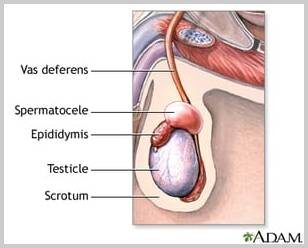
Spermatocele
A spermatocele, also known as a spermatic cyst or epididymal cyst, is a benign growth that develops on the epididymis, the coiled tube located on the upper back side of the testicle in which sperm is stored. The majority of spermatoceles are small and contain a milky fluid that may or may not contain sperm. Although they are harmless, they may sometimes grow in size and cause pain, in which case they may require intervention.
Causes of a Spermatocele
The cause of spermatoceles is largely unknown, but possible causes may include a blockage within the small tubes that drain sperm into the epididymis. Such a blockage may result from irritation, traumatic injury or inflammation, or from fetal exposure to diethylstilbestrol (DES), a synthetic form of estrogen used decades ago to prevent miscarriages. A spermatocele may also be a consequence of a vasectomy. They are very common.
Symptoms of a Spermatocele
Most men who develop spermatoceles do not experience any symptoms. They are often found incidentally when evaluating the scrotum for another reason. Some patients may experience heaviness or dull achy pain within the scrotum, or may be able to palpate a mass behind and above the affected testicle. It may be tender to touch.
Diagnosis of a Spermatocele
Most spermatoceles are discovered during a self-examination of the testicles or during a routine physical examination. Even though a spermatocele may not be painful, the patient may experience discomfort when it is palpated. It is important that a spermatocele be definitively diagnosed to rule out more serious causes for the swelling, such as a testicular tumor. Generally this is done through a scrotal ultrasound and/or transillumination. During transillumination, the doctor shines a light through the patient's scrotum. This light will help provide confirmation that the mass is not a solid tumor but a fluid-filled mass. During the ultrasound test, high-frequency sound waves create precise images of the region that can be used to make certain whether the mass is solid or only filled with fluid. It can provide a lot of valuable diagnostic information.
Treatment of a Spermatocele
While a spermatocele will not normally disappear on its own, it does not usually require any invasive treatment. Any pain the patient experiences normally can be treated effectively with oral analgesics or anti-inflammatory medication. In cases where a spermatocele grows really large or becomes more troublesome, there are several methods that can be used to remove it. These include:
● Surgery to remove the cyst and possible cut some of the nerves around it
● Aspiration to remove the fluid
● Sclerotherapy
Surgery to remove a large spermatocele is a method of correcting the problem. During the surgical procedure, the urologist makes an incision in the scrotum, separates the spermatocele from the epididymis and removes it and sends it off to the pathologist for evaluation. In a less common procedure, the physician may remove the spermatocele by puncturing it with a surgical needle and withdrawing its contents with a syringe, a process known as aspiration. This is not generally recommended as it tends to fill back up with fluid.
The third technique is most frequently used with a recurrent. The physician may aspirate the spermatocele again, but this time inject as irritating chemical back into the hollowed sac to help prevent it from refilling. This irritating chemical, called a sclerosing agent, causes scarring, decreasing the risk that the spermatocele will refill. Sclerotherapy is normally used only in men who are done having children as it may impact their fertility.
